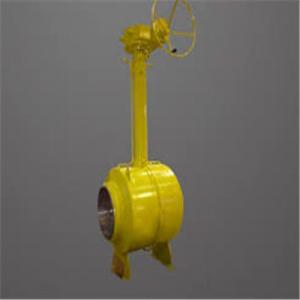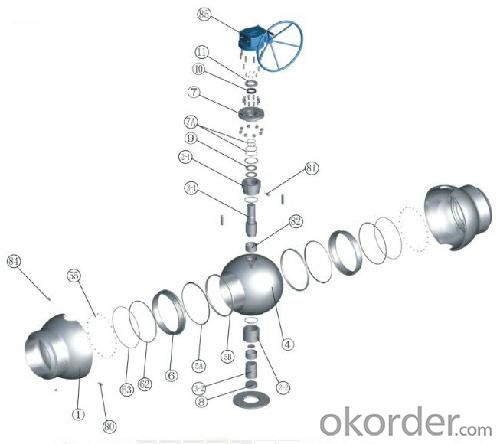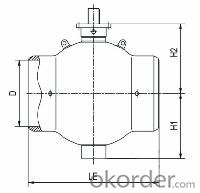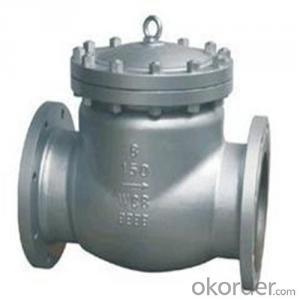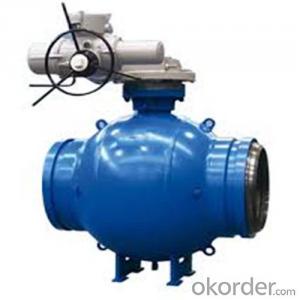Full Welded Forged Steel Ball Valve DN 36 inch
- Loading Port:
- Shanghai
- Payment Terms:
- TT OR LC
- Min Order Qty:
- 10 pc
- Supply Capability:
- 100 pc/month
OKorder Service Pledge
OKorder Financial Service
You Might Also Like
Design Features of full welded forged steel ball valve
The body of ball valve is full welded,selects high quality forged material,and adopts the advanced forged forming technology to form two semi-spheres which are welded into a whole in the middle of the body.This welding technology differentiates the ball valve form others,and makes the valve more spherically,so the valve structure is more compacter,lighter and stronger.Besides,the middle direct welding realize highly accurate valve body manufacturing,makes fully and completely sealing between the seat and ball.The full welding instead of bolts completely avoids the outside leakage,so ball valve is the ideal product for under-ground,offshore working platform and under-sea equipments.
Adopting fixed plates or trunnion to support the ball
The top and bottom of the ball is supported by upper and lower fixed plates or stem and trunnion,and the ball is accurately placed in the center of the ball valve to achieve complete seals and precise movements.When plate adopted,the force exerted by the medium to the ball is distributed via the plate to the left and right bodies,so that the stem does not bear the blending moment from the medium,but only the torque from the ball rotation during the opening/closing of the valve.The low-friction PTFE Teflon composite bearings installed between the ball axis and fixed plate and between the stem and the trunnion can absorb ball moving action caused by the pressure of the medium.This structure brings stable actions and easy operations for the ball valves,and the required operation torque can be reduced,so smaller actuators can be used,and the cost is cut down.
ball valve seat is floating structure,means the seat can move along the medium direction,so that the seat can fit against the ball all the time.
(Ⅰ)Double piston effect structure seat of full welded forged steel ball valve
Seat design is special double pistons effect structure,it can ensure the seal wherever the medium flows into the ball valve.


(Ⅱ)Seat multistage seal strucute of full welded forged steel ball valve
As following graphic instruction,on seat bearing ring,set two soft sealing rings(A and B)and metal sealing spherical surface which can seal with the ball.Seat ring A is spring loaded,which seals the surface with the ball tightly to the surface to form an initial seat;When there is pressure generated from medium,the piston force is generated to make seal ring A elastically deformed and seal ring B fit the surface of the ball surface due to the piston effect caused by area difference,thus the second seal forms.When the medium pressure is rising.It will generate huge pressure to seal ring A and seal ring B,so the two seals have a greater elastic deformation,then metal seal ball surface compact with ball surface to form the third level of metal to metal seal.

(Ⅲ)Secondary seat seal device of full welded forged steel ball valve
As the above graphic instruction,the secondary seal device(seat grease injection valve)can be chosen according to the actual working condition,medium requirement,seal requirement,etc.Seat ring grease injection valve is a one-way valve,installed on the body,which can prevent the leakage and inject grease under the outside force.When secondary seal is required,there is a grease injecting channel and hole on the seat ring.The grease can form a seal between the seat and the ball,and then stop the leakage.

Standards Applied of full welded forged steel ball valve:
Design Standard | API 6D customize |
Connection Standard | ASME B 16.25-2007 ASME B 16.5 ASME B 31.4 ASME B 31.8 DIN GB、GB/T JB、JB/T JIS customize |
Test Standard | API 6D customize |
Face to Face | API 6D customize |
Pressure-teperature rating | ASME B 16.34-2004 customize |
Marking | MSS SP-25 customize |
FAQ of full welded forged steel ball valve:
Q1:I can’t find the type of steel check valve which I need. what can I do?
The chart above only lists out some common composition of steel check valve parts.We may provide other different parts material composition according to the customer's request or the actual valve working condition.
Q2:Which certification do your products pass?
Our products are in accordance with ISO 9001、ISO 14001、API 6A、API 6D、TS CE、API607/6FA/BS6755.
Q3:How can I place an order?
The only one thing you should do is to tell us the sepecification about type 、quantity and mode of transportation, then we will send you quotation within 24 hours.
- Q: I was just wondering if any body got there valve replaced,and if they are still having symptoms..Such as sweating,and shortness of breath.I do not know if i should see a cardologist, or the surgeon who replaced the valve.Any answers would be appreciated.Thank you.
- ASAP to the Doctor. You want to rule out infection first of all and other possible problems.
- Q: my check engine light just came on and i have some oil on the block of my engine, a friend told me that the valve cover gasket needs resealed. could that be why my check engine light is on?
- I changed my vavle cover gasket over the weekend and my check engine light had been on....it is now off. That is the only repairs I have done. I was informed it could be my catalytic convertor causing the check engine light so i have ordered that. However with the light off.....idk lol
- Q: ok, after lots of exploring around online and from some great answers from this site I have found the problem to my explorer. The torque converter solenoid mounting clip broke. thats it!! new question, do i have to take off the valve body to remove the solenoid. If so any tips? its way new territory for me. I hate automatics!!
- What are you? 9 years?
- Q: What are a sing of a bad Idle control valve, will this cause bad mpg?
- Generally, a bad ICV will either be stuck open from carbon or dirt making the idle stay too high. Or dead which usually kills the engine when put in gear. Mileage would be affected, but if it idles good, it's probably ok.
- Q: I have a 2000 Ford Explorer sport(2wd). I live in the Fort worth,Tx area. What would be a resonable price to have this valve changed out with a new one(valve labor)?
- dealership wil prolly charge $150-$175 depending on their labor rates. Might find a local shop to do it for less. Goto autozone and ask them to pull the part and to give you a diagram of where it's located and you can decide if you can do it yourself. EGR Exhaust Gas Recirulator typically is located on the intake manifold. Never been under the hood of an 00 Explorer though.
- Q: how to adjust the valves on a 20 horse power briggs and stratton engine on a sears craftman rideing mower model number 917.276824
- if you would like to see a video go to utube an type in ifixit4u lawn mower repair valve adjustment.
- Q: My question mainly pertains to Electric Motor-driven Motor Operated Valve Actuators.
- Motor Operated Valves
- Q: Hey quick Q, I heard somewhere that you could degrease the the reed valve? I love cleaning up my CR250 as much as I can. I just want to know if this is done, and if you could, tell me where I'm supposed to clean.Thanks.
- The flow of gasoline rushing past the reeds is enough to keep them clean. No degreasing is necessary. Are you sure you didn't hear de-carbonize the power valve? If so, remove the power valve and linkage from the cylinder. Remove hardened deposits with a wire wheel on a bench grinder. Clean the parts with parts cleaner.
- Q: The check engine warning light came on in my car, i went to pump gas and try to start but it wouldn't start. I went to the dealership to let them check up, and they said the problem was the purge valve, it leaked. What is a purge valve and what does it do? Is it common for purge valve to go bad?
- Regardless of vehicle make/model,a purge valve is within the fuel system of your vehicle.It's job is to vacuum off fuel vapors from the fuel tank,to be used when the vehicle is running.It works along with your fuel tank cap,to stop vapors/fumes from venting to the atmosphere.On older cars,with carburetors,it work's on vacuum,when the engine is running. On newer cars, say, 1985 and up [approx.] with computers,it works/ is controled by the computer and at least one sensor.
- Q: We have a main gas valve outside and there's a gas valve by out air condition and we want to know which way if off and on .. Does anybody know !!!
- Generally speaking the valve has a handle that pivots from parallel, to perpendicular. Open is in line, or parallel. Closed is perpendicular. If it's a rotating handle, then the valve stem will be all the way in when closed, or all the way out when open. The valve stem is located in the center of the wheel that you would turn. Hope that works for you.
Send your message to us
Full Welded Forged Steel Ball Valve DN 36 inch
- Loading Port:
- Shanghai
- Payment Terms:
- TT OR LC
- Min Order Qty:
- 10 pc
- Supply Capability:
- 100 pc/month
OKorder Service Pledge
OKorder Financial Service
Similar products
Hot products
Hot Searches
Related keywords
